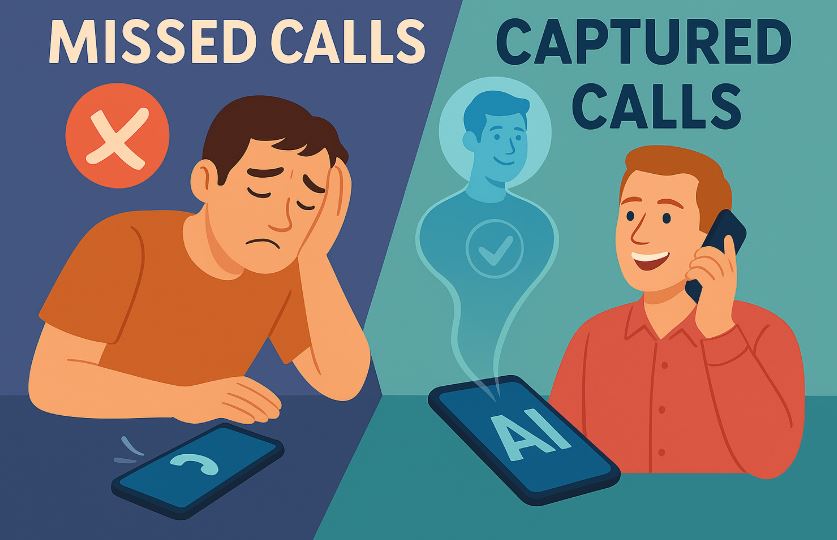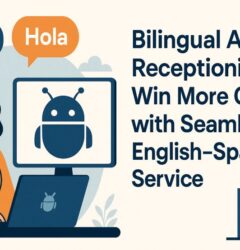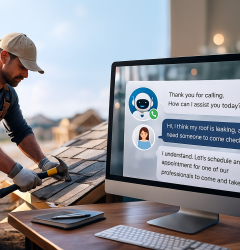
The Midnight‑Call Problem
Here’s a scenario: it’s Saturday at 11 p.m. and a customer’s kitchen pipe has burst. They dial up the first plumber they find on Google, but your office phone rings through to voicemail. Studies show that nearly 47 percent of small businesses miss the initial call which is essentially one in every two leads, simply because no one is there to take it after hours. Every ring that goes unanswered is a customer along with the business that comes with it, going directly to a competitor.
What a 24/7 AI Answering Service Really Does
A 24/7 AI answering service routes your current number to a cloud contact point where conversational AI welcomes the caller, recognizes intent, and acts upon it in real time. It can:
- Answer FAQs in a natural voice
- Book appointments in your synced calendar
- Capture lead information and transfer it into your CRM
- Triage emergencies to an on-call manager or technician
Providers bundle human fallback agents for edge-case questions, so even challenging scenarios never dead-end. The result is a hybrid “always-on” receptionist that works holidays, never calls in sick, and can juggle dozens of calls at once.
Cost Math: 1 Month of Wages vs. 1 Year of an AI Answering Service
The median annual receptionist salary in the United States is $30,450, according to the latest Bureau of Labor Statistics data.
Factor in payroll taxes, benefits, and inevitable turnover, and full‑time coverage can easily top $37k a year. Entry‑level AI answering plans, by contrast, start under $100 a month which is about what you’d spend on an extra coffee run each week. For many small businesses, one month of human payroll is about twelve months of AI coverage.
Missed Calls Equal Lost Revenue: The Hard Numbers
It’s not just convenience at stake, missed calls take a bite out of the bottom line. One study in the U.S. estimates the average revenue loss at $126,360 per year for businesses that regularly send callers to voicemail.
Combine Layer AI call capture with an optimized sales process and you reclaim opportunities already yours, no new ad spend required.

Industry Snapshots: Around‑the‑Clock Wins
- Plumbing (After-Hours Emergencies) – A local plumber that adopted AI call routing witnessed job bookings increase 30 percent during the initial month; weekend leaks that were previously urgent and neglected now convert.
- Restaurants (Late-Night Reservations): AI “hosts” now accept reservation calls for New York and Miami restaurants, enabling staff to concentrate on table service while continuing to seat diners at midnight.
- Home‑Services (HVAC & Pest Control): Voice AI customers experience 37 percent more lead‑to‑appointment conversions and 214 percent more after‑hours bookings, according to recent home‑service case data.
- Law Firms (Lead Intake & Client Screening): A lawyer that swapped its overnight call center for an AI answering service cut after‑hours staffing costs by 60 percent and boosted qualified intakes by 42 percent, all while delivering instant, 24/7 availability to anxious prospective clients.
All the anecdotes share a common thread: the businesses didn’t add more phone lines or hire more staff, they just didn’t let the phone ring out anymore.
ROI Beyond the Missed Call
- Spam Filtering – AI can screen out robocalls before they even reach a human.
- Instant Transcripts – All calls find their way into your CRM or mailbox, keyword searchable.
- Customer Satisfaction – More speedy pick‑ups translate to better Google review sentiment, especially in service verticals where responsiveness is a selling point in itself.
When you turn phone responsiveness into a marketing investment, not a cost center, the ROI snowballs across reputation, lead flow, and operational efficiency.
Setup in Under 15 Minutes
- Forward your number to the service’s cloud gateway.
- Upload FAQs—hours, pricing, common questions usually via drag‑and‑drop or even a link to your website.
- Set up escalation rules (e.g. “If caller says ’emergency,’ patch to cell”).
- Turn on CRM sync so transcripts and caller details auto‑populate.
Most platforms offer a guided wizard so by the time you finish your coffee, the first test call is live.
Overcoming Common Objections
“Will callers notice it’s AI?”
Advanced neural voices and contextual memory enable free-flowing conversation so fallback agents handle edge cases the AI isn’t yet able to parse. In short, many customers will be able to tell it’s AI, but that will change as the technology keeps advancing.
“Can it handle complex queries?”
Hybrid models escalate niche or emotional calls to a human, but 80 percent of interactions including pricing, availability, appointment changes can stay with the 24/7 AI receptionist.
“Is my data secure?”
Look for SOC 2 or HIPAA‑compliant tiers. Encryption in transit and at rest is now baseline, not a premium add‑on.
Checklist: Is 24/7 AI Right for You?
| Question | If you answer “yes,” AI likely pays off |
|---|---|
| Do > 25 % of calls arrive after hours or during lunch? |  |
| Do callers often ask routine questions you could script? |  |
| Is a full‑time receptionist financially out of reach? |  |
| Do you already use a CRM or booking tool? |  |
| Would bilingual or multilingual support boost sales? |  |
Case Snapshot: A Weekend Trial That Paid for Itself
Dr. Harris, a solo dentist in Dallas, directed her office number to an AI answering service on a Friday afternoon. By Monday morning she had:
- 312 after‑hours calls answered
- 46 emergency appointments scheduled
- only 7 calls escalated to her cell
Total added production revenue (crowns, root canals, follow‑ups): $18,400. Annual AI subscription: $1,200. She never went back to voicemail.
Looking Beyond Price When Choosing a Provider
Subscription cost and included minutes matter, but so does brains behind the voice. While some providers rely on static decision trees that you’ll have to update manually, others are continuously learning from each call, ingesting webpages and past transcripts to refine responses. Opt for platforms with dynamic learning pipelines and open APIs so your future self will thank you when you transition to text or chat without having to start re‑training from scratch.
Future‑Proofing Your Customer‑Experience Strategy
The roadmap for voice AI already includes real‑time sentiment analysis, auto‑translation, and write‑backs into CRMs like HubSpot or Zoho. Choosing a provider committed to open integrations insulates you from lock‑in and enables you to add new channels such as AI outbound reminders or SMS follow‑ups onto the same platform with minimal friction. Today’s 24/7 AI answering service can evolve into tomorrow’s full omnichannel communication hub with minimal friction.
Along with simply answering calls, an always‑on AI receptionist also reinforces your brand voice each time the phone rings. Because the system draws responses from a knowledge base that you develop, and because you can modify tone, formality, and even regional flair, it welcomes callers with the same personality at midnight on Saturday as at 9AM. on Monday. That degree of consistency is all but impossible with rotating staff or outsourced overnight reps, yet it’s embedded in a properly trained language model. The outcome is a tighter, more reliable customer experience that builds trust each time a prospect or client phones in.
No less important, the software makes measuring success incredibly easy. Recordings, transcripts, and performance dashboards expose metrics that traditional phone coverage can’t start to quantify. Think average response time, appointment-conversion rate, and even sentiment analysis of caller tone. Reviewing these analytics after your initial 30 days lets you put a quantity on the ROI you’re anecdotally feeling and identify edge cases where a simple script change could drive conversions even higher. The data closes the loop between “we think it’s working” and “here’s the proof that it’s paying for itself.”
Next Steps: Put It to the Weekend Test
Forward your line this Friday evening and let the AI run through Sunday. Compare Monday’s call logs, booked revenue, and customer satisfaction to your usual voicemail pile. If the numbers align with the statistics and case studies above, you’ll have proof, grounded in your own data, that 24/7 AI answering service coverage isn’t just a cool gadget. It’s a revenue engine waiting to be switched on.


